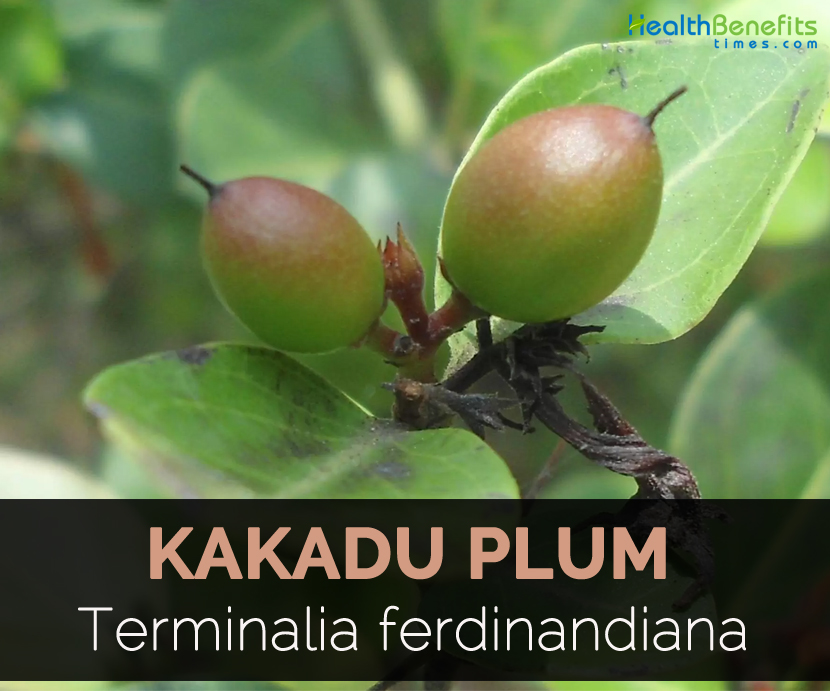| Kakadu plum Quick Facts | |
|---|---|
| Name: | Kakadu plum |
| Scientific Name: | Terminalia ferdinandiana |
| Origin | Native to Australia |
| Colors | Yellow-green |
| Shapes | Ovoid, 2 cm long by 1 cm wide |
| Taste | Tart, bitter |
| Name | Kakadu plum |
|---|---|
| Scientific Name | Terminalia ferdinandiana |
| Native | Native to Australia |
| Common/English Name | Billy Goat Plum, Gubinge, Green Plum, Salty Plum, Kakadu Plum, Wild Plum |
| Name in Other Languages | Australia: Gubinge, Marnybi, Manmohpan, Murunga (Aboriginal), Madoorr, Arangal, Gubinge (Bardi People) Kabinyn (Nyul Nyul) and Gabiny (Yawuru) English: Billygoat plum (Aust.), Gubinge, Kakadu plum (Aust.), Murunga |
| Plant Growth Habit | Slender, spreading tree |
| Plant Size | 10 m high |
| Bark | Rough, cream-grey |
| Leaf | Leathery, glabrous, broadly elliptical to ovate, 15–22 cm long by 12–20 cm wide |
| Flowering Season | September to December |
| Flower | Small, creamywhite |
| Fruit shape & size | Ovoid, 2 cm long by 1 cm wide |
| Fruit weight | 0.1–0.2 ounces (2–5 grams) |
| Fruit color | Yellow-green |
| Fruit peel | Smooth |
| Fruit Taste | Tart, bitter |
Plant description
A slender and spreading tree which reaches 10 meters high with rough cream-grey bark i.e. flaky in larger trees. Leaves are light green, leathery, glabrous, broadly elliptical to ovate about 15-22 cm long by 12-20 cm wide with distinct veins and spirally arranged towards the end of branches. Flowers are small creamy white and perfumed borne on spikes 20 cm long in leaf axils. Fruit is fleshy and void with short beaked about 2 cm long by 1 cm wide, yellow-green with reddish tint and contains one large seed. The flower blooms at the end of dry season from September to November.
Health Benefits of Kakadu plum
- Prevent microbes
The study conducted showed antimicrobial properties of Kakadu plum extracts of leaves and fruit against common food borne bacteria. The results concluded that fruits and leaves have potential as natural preservatives in the food industry. The bioactive compounds found in Kakadu plum needs to determine the compounds which is responsible for antimicrobial activities.
- Antioxidant activity
Kakadu plum has antioxidants more in comparison to blueberry. It offers 4.7 times more phenolic compounds and 10 times more potassium. The examination of Australian commercially grown fruits revealed hydrophilic phytochemicals and antioxidants it possess. It has more total phenolic compounds in comparison to blueberry and studied as cancer fighting foods due to phytonutrients it contains.
- Strengthen immune system
Vitamin C is a nutrient for those who undergoes stress, drinking alcohol, smoking and engage in other nutrient depleting activities such as endurance sports. The compromised immune system results one to catch cold whenever one travels. Kakadu plum has various levels of phenolic compounds, sugars, Vitamin C and antioxidants.
- Cardiovascular health
Kakadu plum is the food rich in Vitamin C which helps to protect against coronary heart disease. The study conducted on 9187 men and 11,112 women aged 3.9 to 79 years showed decrease in heart failure with increase in plasma Vitamin C.
- Combat Alzheimer’s
Kakadu plum has antioxidant properties which is seven times greater than curcumin. The protective ability of Kakadu plum makes it more powerful than turmeric. Antioxidants found in Kakadu plum combats free radical damage and acts as potential treatment for Alzheimer’s.
- Lowers appearance of wrinkles
Vitamin helps to lower wrinkles and age spots. Vitamin C enhances production of collagen, reduces hyperpigmentation and prevents skin changes caused by photoaging. Study shows that topical application of Vitamin C helps to lower wrinkles along with skin texture and skin tone changes. It has minerals and antioxidant which nourish and invigorate skin including zinc, Vitamin E, lutein, folate, iron and prevents premature aging.
- Skin infections
Inner bark of Kakadu plum tree helps to cure skin disorders and infections. It is used to heal sores, wounds and boils. It helps to prevent fungal or bacterial infections. It helps to heal wounds and treat psoriasis.
- Hair health
Kakadu plum moisturizes and hydrates hair. It maintains collagen level and elastin which is essential for healthy and lustrous hair. It hydrates and detangles hair. Regular use of shampoo smoothens and hydrates normal to dry hair.
Traditional uses
- Kakadu plums are used for treating flu, colds and headaches.
- It is used as an antiseptic or soothing balm for limbs.
- Root infusion is used for treating stomach pain and urinary disorders.
- Stem decoction is used for treating boils, skin disorders and rashes.
- Inhale the whole plant for treating viral disorders such as influenza and colds.
- Indigenous people use the roasted sap and boiled bark is used for treating skin conditions, sores and drunk as tea for colds and flu.
- Apply the bark to infections and burn injuries.
- Use the sap of the tree for treating joint inflammation.
Culinary uses
- In North Western and Northern Australia, Kakadu plum is consumed raw or prepared into drinks.
- Fruits are used to make refreshing drink.
- The fruit flesh is used for preserves, jams, sauces, relishes, juices, sauces and ice cream.
- It is also found in fresh, powdered or frozen puree form.
Storage
Freeze it within 24 hours of harvest to maintain its size and quality.
References:
https://www.ncbi.nlm.nih.gov/pmc/articles/PMC6724055/
https://pfaf.org/user/Plant.aspx?LatinName=Terminalia+ferdinandiana
https://en.wikipedia.org/wiki/Terminalia_ferdinandiana
http://tasteaustralia.biz/bushfood/native-fruit/kakadu-plum/
https://draxe.com/nutrition/kakadu-plum/
https://www.stylecraze.com/articles/benefits-of-kakadu-plum-for-skin-hair-and-health/#gref
Comments
comments
